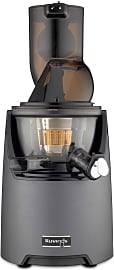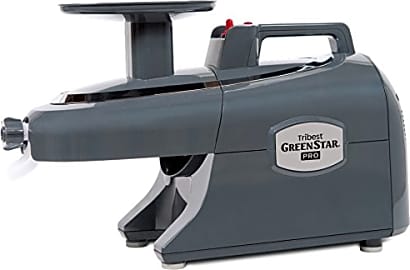The 10 Best Juicers

This wiki has been updated 45 times since it was first published in April of 2015. Juicing has come a long way since the days of strainer bowls and elbow grease. From high-speed centrifugal models to the heavy-duty masticators recommended for cleanses and commercial establishments, there's something in our selection for anyone who's looking to enjoy fresh goodness in liquid form. We've ranked them by their efficiency, as well as their ease of use and cleanup. When users buy our independently chosen editorial recommendations, we may earn commissions to help fund the Wiki.
Editor's Notes
March 30, 2021:
We noticed that the Kuvings CS700 wasn’t available at the time of this update, so we went ahead and replaced it with the Kuvings EVO820GM — a well-reviewed alternative from the company that, at 50 rotations per minute, wound up being the slowest turning option we ranked (which, for the uninitiated, is generally considered to be a good thing).
The Omega J8007S was still available, but we noticed its manufacturer recently discontinued it, and so we thought it best to get ahead of its inevitable disappearance and replace it with the Omega J8006HDS — which has a design quite similar to our previous pick, but features a BPA-free construction that translates to some formerly plastic hardware being upgraded to stainless steel. Compared side by side, this new model should purportedly produce more juice than its predecessor, when used properly.
The Super Angel Deluxe was also missing in action, but we didn’t mind terribly, as it made room for our rankings to accommodate the Pure DB1 Two-Stage, which quickly snagged a spot at the top of our list. It’s a pricey option, to be sure, but the company claims the difference in cost comes back quickly with all the extra juice the unit will extract, thanks to its hydraulic press that exerts 5,400 pounds of force onto your pulverized produce. Considering that its priced at more than triple the cost of our next closest option, we’re skeptical about just how easy it will be – for even the most avid juicer – to recover that kind of difference. But, the machine is backed by a 12-year transferable warranty, so I suppose you don’t have to get your money back overnight.
We like to maintain this page as a starting point, for our users who are just starting to research the purchase, but if you’ve already done a bit of learning and have got a clue regarding what specific sort of juicer you want, then feel free to jump over to one our specialized lists for centrifugal juicers, masticating juicers or citrus juicers.
January 20, 2020:
Given the superior nutrient and enzyme content that comes out of masticating juicers, it's no surprise that they dominate our ranking. This is one category in which faster motors are actually a bad thing, as you want more torque at slower speeds with these devices to effectively remove juice without generating heat from friction that can kill and oxidize valuable components. That said, many centrifugal models are faster and easier to clean than masticators, so they aren't completely gone from our list.
The traditional masticator, embodied in models like the Tribest Greenstar Pro GS-P502 and the Champion G5-PG710, create a horizontal pathway for ingredients to travel. Some of the more modern machines have vertical chutes and augers that look like centrifugal juicers at first glance, but are designed to function the same way as these other masticators, but with gravity on their side for the movement of ingredients. For some reason, however, it seems that vertical models like the Kuvings NSF Whole Slow CS700, that are on par with the pro-grade horizontal masticators, come with pretty high price tags. There are cheaper options out there, but they often sacrifice things that the horizontal models in their class still offer.
Special Honors
Cecilware JX45AF The price tag and 45-orange capacity that come with this one suggest that it's intended for restaurant use, but as a 120-volt appliance with a nine-amp rating, there's nothing (other than space, likely) preventing you from integrating it into your own kitchen. It's available with two-, three- and five-year extended warranties. webstaurantstore.com
JBT Point-of-Sale Juicers This company offers several retail-ready juicers, equipped with impressive specifications like 15-pound fruit hoppers and 43-liter-per-hour outputs. Quotations are available on request. jbtc.com
The Juice Is Loose
There, stomach acids break the kale down even further, passing what's left of the process into your intestines, which drink up all the available nutrients from the process.
Fresh juices, whether derived from fruits or vegetables, have more bioavailability than the fruits or veggies do on their own. It's a pretty simple formula when you think about it. You take a bite of kale, chew it less than the recommended number of chews per bite of food, and swallow. Your body then goes to work at pushing the kale through your system, breaking it down first with saliva and its attendant enzyme activity on the way to the stomach. There, stomach acids break the kale down even further, passing what's left of the process into your intestines, which drink up all the available nutrients from the process.
From the moment the food enters your mouth, your body has the ability to absorb its nutrients. Usually, however, the mouth and the stomach are so busy breaking foods down to a digestible point that they don't have time to absorb any of those micro-nutrients that might otherwise pass the membranes in your mouth and esophagus and get right into your bloodstream.
Take a look at a smart hippie in the late 1960s, by way of example. When he takes a tab of acid, he doesn't just swallow it. If he waits for his stomach to break down the tab and let the LSD into his system, it could be the better part of an hour before he feels anything. Instead, he rolls the tab around in his mouth, letting the chemical pass through the membranes in his mouth and absorb into the capillary activity there, creating a much faster effect.
The same goes for your food. When you drop a carrot into a juicer, that juicer, by means of either extraction or mastication, separates its juices and all of those great nutrients from its fibrous material. When you drink that juice, the moment it hits your mouth you begin to absorb those nutrients, and you continue to do so all the way through the stomach, creating an experience of greater bioavailability, or, literally, the ability your body has to access all the good stuff.
To Chew Or To Shred
You've probably heard that juicing is bad because it oxidizes or overheats the material and that it removes all that wonderful fiber. Well, these are partial truths, that examination of which should help you decide which of the juicers on our list is right for you.
You've probably heard that juicing is bad because it oxidizes or overheats the material and that it removes all that wonderful fiber.
As for the claim about heat and oxidization, it's true that juicing oxidizes food. Anything in an oxygen-rich environment (like the Earth's atmosphere, for example), will oxidize. Moisture increases this exchange, which is why fruits and veggies shrivel up more quickly after you cut them; their insides tend to be wetter than their outsides. Juice is about as moist as it can get, so your mixture will likely lose a good portion of its enzyme activity to oxidization within the first 20 minutes after juicing. The good news there is that you can keep the majority of your enzymes just by drinking your juice as soon as you make it.
The heat claim is more pertinent among the extraction juicers on our list than the masticating juicers. Extraction juicers spin a thin, sharp webbing of blades beneath a tube through which you feed and push foods. Those blades shred the fiber and send it flying into a reservoir, while the liquid left over from the process heads into your glass. The friction that those fast-moving blades create against your food does create some heat, but not enough to meaningfully harm your juice.
Masticating juicers work in a similar fashion, but they have a rotating set of teeth that move very slowly in a confined area, simulating the process of very powerful jaws chewing your food for you. They tend to get more juice out of the material you feed through them, as the fiber that lands in their reservoirs is noticeably drier than that of the extraction juicers.
As for the fiber, I'll borrow a line usually reserved for gun control debates. Juicers don't get rid of fiber; people who use juicers get rid of fiber. It's all right there for you to use in a million different ways. There are books and websites devoted to what you can do with that fibrous material, so don't buy into the myth that it magically goes to waste.
One other important thing to mention is that none of these juicers are easy to clean. If one says they're easy to clean, that only means they're easy to clean compared to other juicers. Juicing is inherently a messy process, but every moment spent cleaning and reassembling your juicer is a moment spent in undeniably greater health.
Old Medicine, New Means
Even without advanced mechanical intervention, humans have long combined mashed versions of fruits and vegetables for their healing abilities, applied both internally and externally. As far back as the first century C.E., in the Dead Sea Scrolls, we can find evidence of a pounded mash of pomegranate and fig that sounds pretty tasty.
Mechanical intervention finally arrived in the early 20th century.
Mechanical intervention finally arrived in the early 20th century. In 1936, Dr. Norman Walker published a book called Raw Vegetable Juices, which led to the development of the Norwalk juicer, which is still one of the revered brands in the industry.
Throughout the next several decades, new players entered the market, jockeying for superiority in their juice quality and, most importantly, in their ease of cleanup. In the past few decades, partially fueled by the rapid decline of the Western diet, as well as the success of chains like Jamba Juice and Smoothie King, the average person's appetite for juice has reached new heights, and there are more options available now than ever before.















